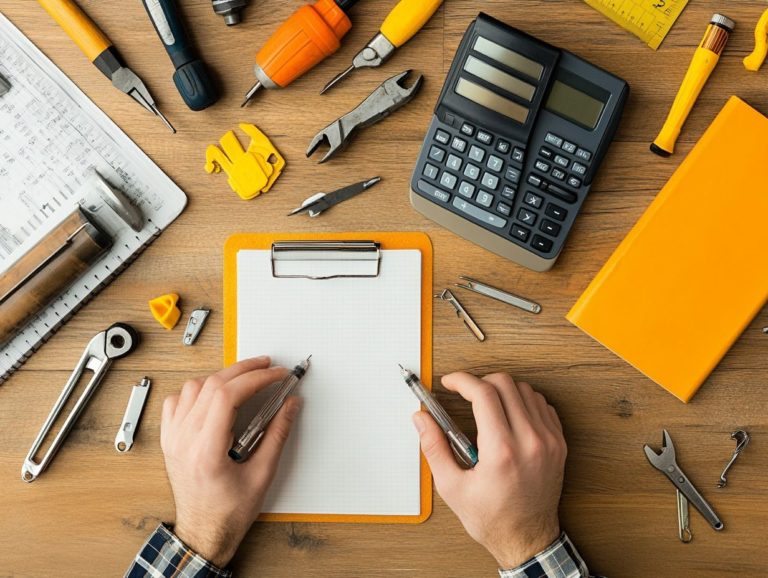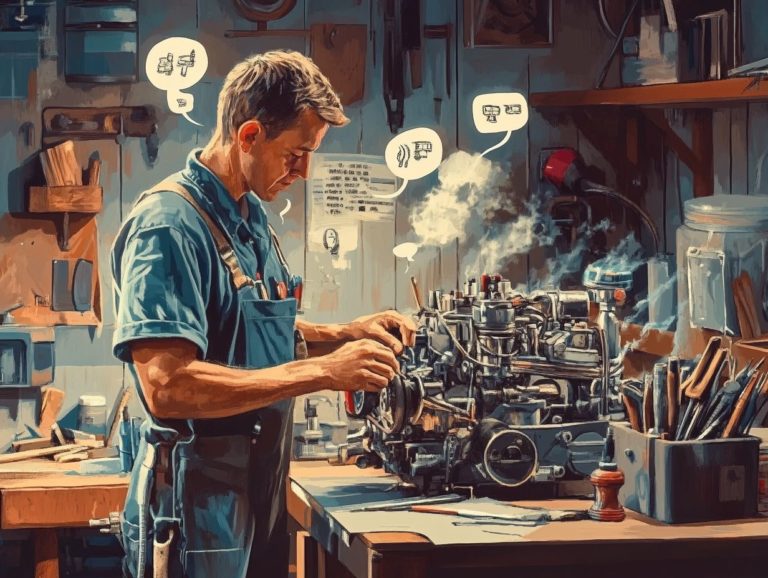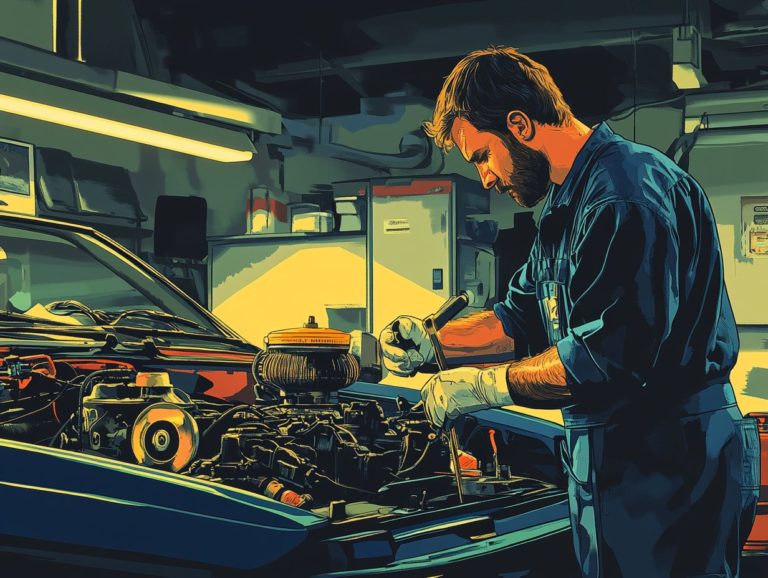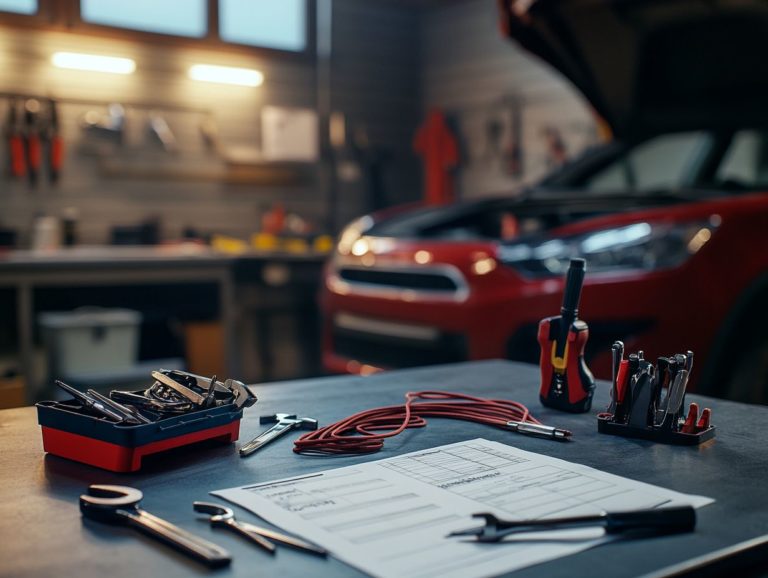Common Repairs Every New Driver Should Know
Every new driver must confront the realities of car ownership, which inevitably includes the need for repairs.
Grasping basic maintenance principles can save you time, money, and future headaches. Whether it s changing a flat tire or swapping out a headlight, knowing how to handle these common issues is essential for any driver.
This guide presents 15 key repairs every new driver should be acquainted with, along with insights on essential tools, maintenance practices, and recognizing when your vehicle requires attention.
Equip yourself with the knowledge to ensure your vehicle runs smoothly and efficiently!
Contents
- Key Takeaways:
- 1. How to Change a Flat Tire
- 2. How to Jump-Start a Car
- 3. How to Replace Windshield Wipers
- 4. How to Change the Oil
- 5. How to Replace a Headlight or Taillight
- 6. How to Change a Car Battery
- 7. How to Replace Brake Pads
- 8. How to Fix a Leaking Radiator
- 9. How to Replace a Serpentine Belt
- 10. How to Change the Air Filter
- 11. How to Fix a Stuck Gas Cap
- 12. How to Replace Spark Plugs
- 13. How to Fix a Clogged Fuel Filter
- 14. How to Replace a Thermostat
- 15. How to Fix a Cracked Windshield
- What Are the Most Common Car Repairs Needed for New Drivers?
- Frequently Asked Questions
Key Takeaways:
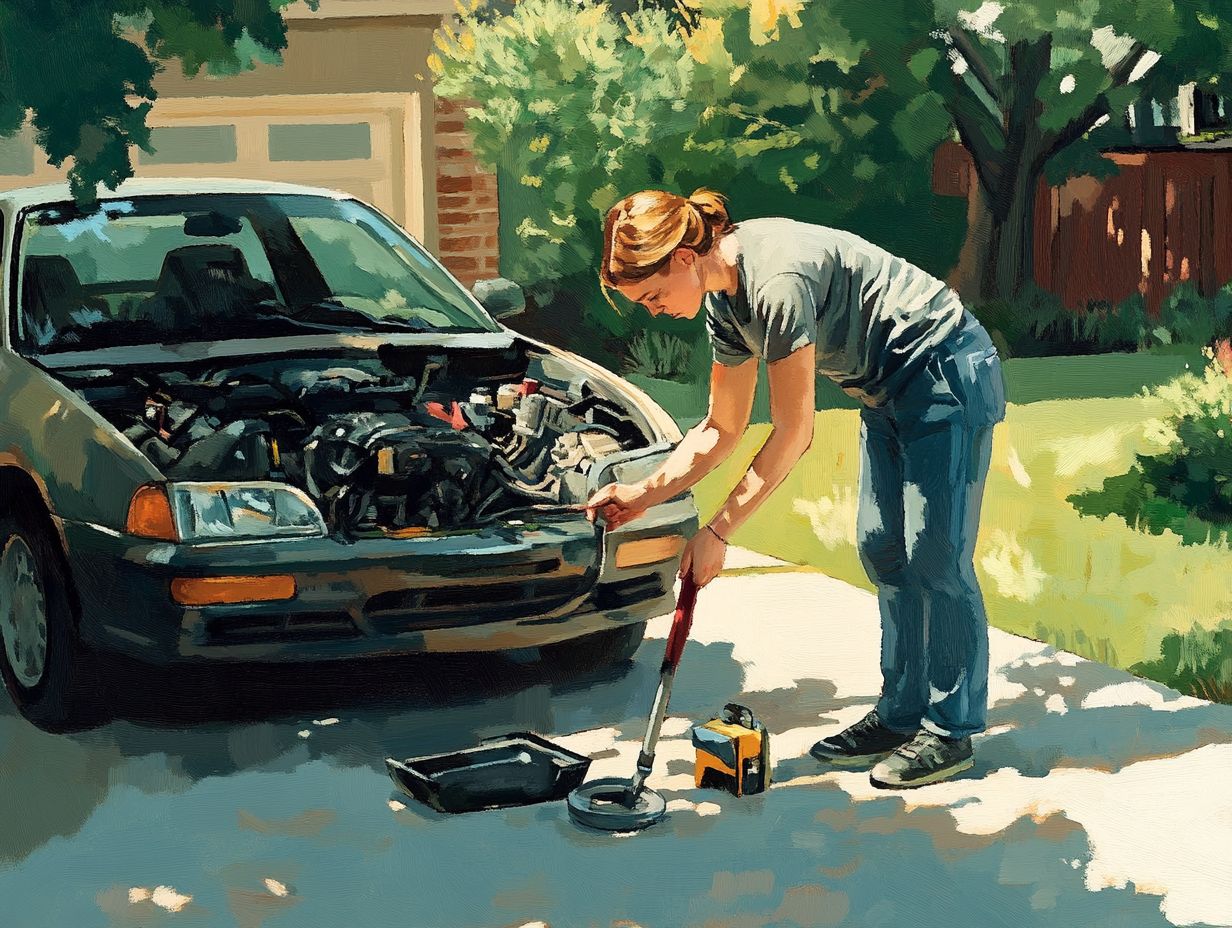
- Knowing how to change a flat tire is essential for new drivers to avoid being stranded on the road.
- Jump-starting a car can save you from the inconvenience of a dead battery.
- Replacing windshield wipers is crucial for maintaining visibility and safety while driving in rain or snow.
1. How to Change a Flat Tire
Changing a flat tire is an important skill you should master. It ensures your vehicle’s safety and prepares you for unexpected roadside challenges.
Equipping yourself with the right tools and knowledge makes this process smoother and safer. Start by gathering your essential tools:
- A jack is essential for lifting your vehicle.
- A lug wrench is needed to remove and tighten the lug nuts.
- A spare tire that s fully inflated and ready for action.
Before you dive in, find a safe, level area to park preferably away from traffic. Wearing reflective gear and using warning lights will enhance your visibility and keep you safe from potential accidents.
Once you’ve replaced the tire, check the pressure of all your tires to ensure you re set for optimal driving conditions.
2. How to Jump-Start a Car
Jump-starting a car is an essential skill that helps you maintain battery performance and get back on the road swiftly, especially as a new driver.
Understanding this process eases the annoyance of unexpected breakdowns and equips you to tackle the task safely and confidently.
- Gather the appropriate jumper cables, ensuring they re in good condition to handle the current.
- Park the assisting vehicle close enough for the cables to reach, and turn off both ignitions.
- Connect the red cable to the positive terminal of the dead battery first, then attach it to the positive terminal of the functioning battery.
- Attach the black cable to the negative terminal of the working battery, then connect it to a grounded metal surface on the dead vehicle instead of the negative terminal to reduce the risk of sparks.
Always wear gloves and eye protection, and keep an emergency kit in your car for any roadside situations. A well-prepared driver prioritizes vehicle safety for a smoother overall experience.
3. How to Replace Windshield Wipers
Replacing windshield wipers is a crucial maintenance task that significantly enhances your visibility on the road and boosts vehicle safety. It s an essential skill for any car owner, especially for new drivers who might overlook this simple yet impactful habit.
Understanding the different types of windshield wipers available helps you select the best option for your vehicle. There are traditional frame-style wipers, beam wipers designed for optimal contact, and hybrid wipers that combine features of both. Each type serves a specific purpose and performs differently based on weather conditions.
Choosing the right size is equally important; using properly fitting wipers ensures maximum coverage and efficiency. Look out for these signs that indicate it’s time for a replacement:
- Streaking on your windshield.
- Skipping during operation.
- Squeaking sounds while in use.
To replace them, lift the wiper arms, unclip the old blades, and securely attach the new ones, ensuring they fit correctly for smooth operation.
Start practicing these skills today and drive with confidence!
4. How to Change the Oil
Changing the oil is a key part of car maintenance. It helps your engine run smoothly and extends your vehicle’s lifespan. New drivers must understand this task to take responsibility for their car s upkeep.
Regularly checking your oil level helps you know when it s time for a change. To start, drain the old oil by using a wrench to remove the drain plug and letting the used oil flow out completely.
Next, replacing the oil filter is essential. It captures contaminants that can harm your engine. Once the old oil has been drained and the filter replaced, add fresh engine oil to keep everything well lubricated.
Stick to a maintenance schedule and check your oil levels regularly. This can prevent engine wear and enhance fuel efficiency and performance, contributing to your overall driving safety.
5. How to Replace a Headlight or Taillight
Replacing a headlight or taillight is a vital DIY task. It boosts your vehicle’s safety during nighttime driving and helps you become familiar with the various parts of your car and what they need.
Know the common types of headlights halogen, LED, and HID and different taillight options to tackle this task. Knowing how to replace these bulbs safely is important. Always ensure the vehicle is turned off and the keys are removed.
Watch for the warning lights on your dashboard. They can alert you to bulb failures and help you avoid hazards on the road. Prioritize quality auto parts for longevity and optimal performance, ensuring a safer driving experience.
6. How to Change a Car Battery
Changing a car battery is a key maintenance task that affects battery performance and your vehicle’s reliability. It’s an essential skill for every driver, especially new ones navigating car ownership with confidence.
Understanding the steps involved demystifies the process. Start by gathering necessary tools, including a wrench, safety gloves, and eye protection. Always check your battery s health to avoid unexpected breakdowns! A visual inspection can reveal corrosion or leaks, and a multimeter tests battery voltage.
Ensure safety by disconnecting the negative terminal first. This allows you to easily remove the battery. Choosing the right battery for your vehicle s specifications is crucial, as it impacts starting power and longevity. By taking these precautions, you ll ensure a successful replacement and extend the life of your new battery.
7. How to Replace Brake Pads

Replacing brake pads is a vital task that impacts your vehicle’s safety and driving performance. It s essential to know the parts of your vehicle, especially if you’re a new driver keeping your car in top-notch, road-ready condition.
Be aware of signs that your brake pads are worn. If you hear a squeaking or grinding noise while braking, or experience reduced responsiveness, these are urgent signals that a replacement is needed.
Follow a clear, step-by-step process for replacing brake pads to keep your vehicle safe. Check your brake fluid levels after replacing the pads. Insufficient fluid can severely compromise brake efficiency.
Ignoring this maintenance can lead to diminished stopping power, putting your safety and the safety of others at risk. Don t put off replacing those brake pads! Your safety depends on it!
8. How to Fix a Leaking Radiator
Fixing a leaking radiator is essential for maintaining the best engine temperature and preventing serious engine issues. It s a critical maintenance task that every new driver should understand as part of their vehicle care routine.
Being able to identify the signs of a leaking radiator can save you both time and money on automotive repairs. Start by inspecting the coolant levels, ensuring they are within the recommended range. This is your first step in determining whether a leak exists.
Next, check the hoses connected to the radiator for signs of wear or damage to find the leak.
Driving with a leaking radiator not only risks overheating your engine but can also lead to far more severe mechanical failures. Don t ignore a leak! Address it immediately to prevent overheating and severe damage. In emergency situations, it s wise to pull over, allow the engine to cool down, and call for assistance to prevent further damage.
9. How to Replace a Serpentine Belt
Replacing a serpentine belt is an essential maintenance task that can save you from significant engine troubles while keeping your vehicle in peak condition. It s crucial knowledge for new drivers as you navigate the ins and outs of your car’s service needs.
The serpentine belt powers parts like the alternator, power steering pump, and air conditioning compressor. Over time, wear and tear can lead to cracking, fraying, or slipping, which may result in signs like squealing noises, a loss of power steering, or overheating. Spotting these signs early can spare you from costly repairs down the line.
To replace the serpentine belt, follow these steps:
- Disconnect the negative battery terminal.
- Relieve tension on the belt using a wrench on the tensioner.
- Carefully remove the old belt while taking note of the routing path.
- Install the new belt, ensuring it sits securely on all pulleys.
- Reconnect the battery and start the engine to check for any issues.
This process keeps your car running smoothly and saves you from unexpected failures!
10. How to Change the Air Filter
Changing the air filter is an essential maintenance task that greatly impacts engine performance and longevity. It s a vital skill every new driver should cultivate as part of their overall vehicle care regimen.
When you keep your air filter clean, you allow the engine to breathe more easily, enhancing the airflow necessary for optimal combustion. This not only boosts your vehicle’s power and efficiency but also helps extend the engine’s life by reducing wear and tear.
Checking the air filter is a straightforward process. Typically, you can inspect it visually for dirt and grime, or consult your vehicle s manual for specific replacement intervals.
If you often drive in dusty or urban areas, it s wise to check and replace the filter more frequently. Ultimately, maintaining a clean air filter can lead to better fuel efficiency, translating into savings at the pump while contributing to a cleaner environment.
11. How to Fix a Stuck Gas Cap
Fixing a stuck gas cap may seem like a minor task, but it s an essential DIY maintenance step that can prevent fuel leaks and enhance vehicle safety. For new drivers, mastering these small repairs can greatly boost their automotive confidence.
Several common factors might cause a gas cap to get stuck. You might find dirt and debris accumulating around the threads, or the cap could be overtightened during a previous fill-up. In some situations, the locking mechanism might malfunction, making it tricky to unlock the cap.
To safely remove it, gently wiggle and turn the cap while applying a bit of lubricant to loosen any built-up grime.
When it s time to select a replacement gas cap, ensure it aligns perfectly with your vehicle’s specifications for a proper seal. A tight and secure seal will not only prevent harmful vapors from escaping but will also help maintain your vehicle’s overall performance.
12. How to Replace Spark Plugs
Replacing spark plugs is a fundamental maintenance task that guarantees your engine performs at its best and achieves optimal fuel efficiency. This essential skill is crucial for your vehicle maintenance routine.
If you overlook this task, you could face problems like rough idling, sluggish acceleration, and even higher emissions. Spark plugs ignite the air-fuel mixture in your engine, fueling the combustion process that keeps your vehicle running smoothly.
It s vital to recognize signs of wear, such as corrosion, soot buildup, or gaps that are too wide or too narrow. These indicators suggest that a replacement is necessary.
The replacement process involves a few straightforward steps:
- Remove the spark plug wires.
- Use a socket wrench to unscrew the old plugs.
- Ensure the new ones are gapped correctly before installation.
Most importantly, using the right type of spark plug based on your vehicle s specific requirements is essential for maintaining engine health and performance.
13. How to Fix a Clogged Fuel Filter
Fixing a clogged fuel filter is vital for maintaining your engine’s health and ensuring your vehicle operates smoothly. As a new driver, mastering this maintenance task will help you navigate your driving responsibilities with confidence.
Understanding how a clean fuel filter directly impacts engine performance enables you to take proactive steps in caring for your vehicle. If you notice difficulty starting your engine, decreased power during acceleration, or stalling, those could be signs of a clogged fuel filter. Ignoring these symptoms may lead to serious complications.
To replace the fuel filter, follow these steps:
- Ensure the engine is off and cool.
- Relieve the fuel pressure (this means releasing the built-up pressure in the fuel system).
- Disconnect the old filter.
- Install the new one according to proper guidelines.
Remember, a clean filter boosts fuel efficiency and extends your engine’s lifespan, resulting in a smoother driving experience.
14. How to Replace a Thermostat
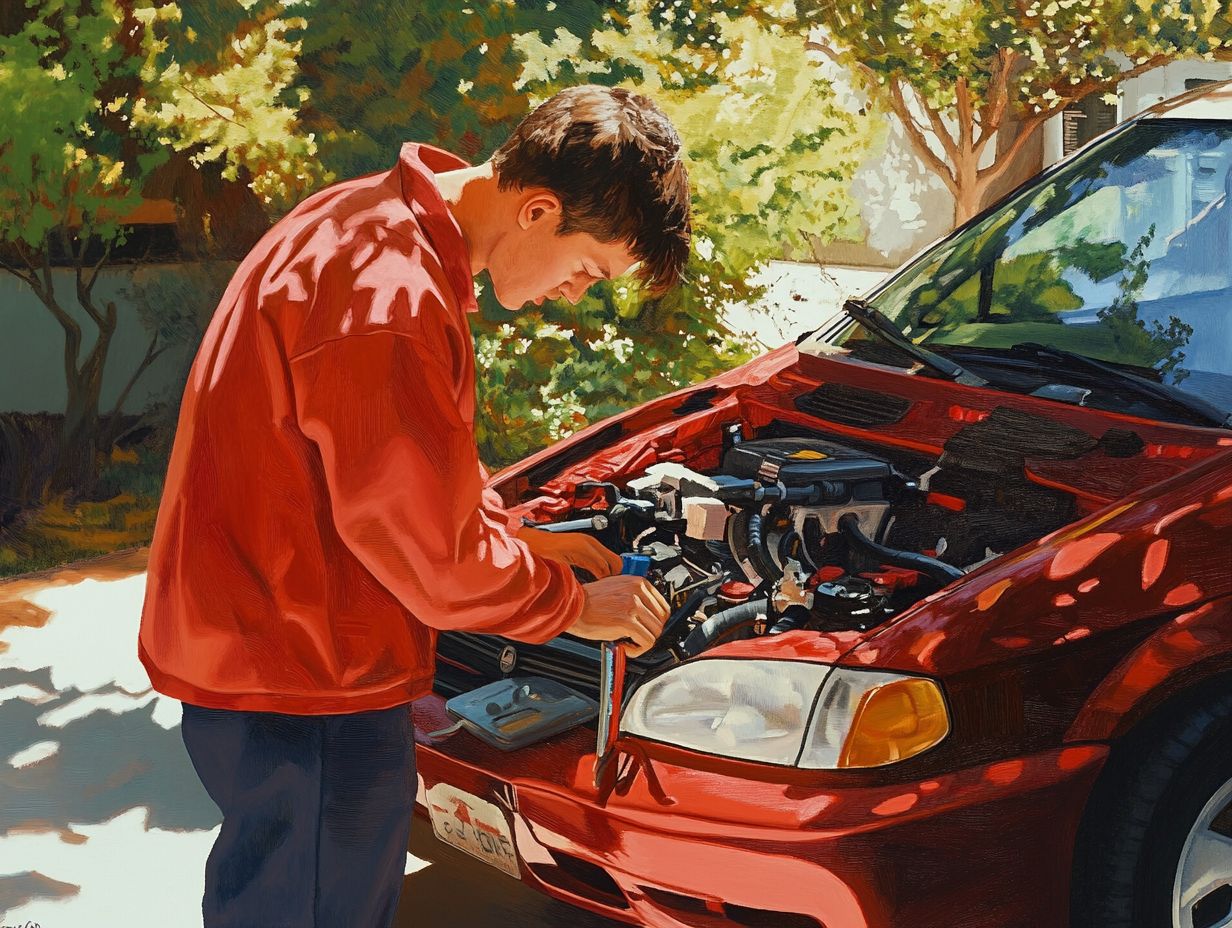
Replacing a thermostat is key for regulating your engine s temperature and preventing overheating, making it a crucial maintenance task for you as a new driver. Understanding this process ensures the safety and performance of your vehicle.
The thermostat plays an important role in managing coolant flow within the engine, ensuring it operates within an optimal temperature range. Be vigilant about signs indicating a thermostat not working properly. Watch for fluctuating temperature readings, a check engine light, or leaks around the engine. Act fast if you notice these signs to prevent serious engine damage!
The replacement process typically involves a few straightforward steps:
- Drain the cooling system.
- Remove the old thermostat.
- Install a new one.
- Refill and bleed the coolant system.
Consistently monitoring your engine temperature is essential. Neglecting this can lead to overheating, which compromises your vehicle’s performance and longevity. Taking these proactive measures ensures your vehicle runs smoothly for years.
15. How to Fix a Cracked Windshield
Fixing a cracked windshield is crucial for maintaining your vehicle’s safety and ensuring you have clear visibility while driving. This skill is particularly important for new drivers as they familiarize themselves with essential safety tips.
You have several options for addressing this common issue, from simple DIY kits for minor cracks to professional services for larger damage. Evaluate the size and location of the crack; if it s less than six inches and not in your line of sight, a DIY repair might be worth considering. For larger cracks that obstruct your view, seek professional assistance.
Keeping an emergency kit in your vehicle provides peace of mind, equipping you with the essential tools to handle such situations effectively.
What Are the Most Common Car Repairs Needed for New Drivers?
New drivers must know common car repairs. This helps maintain safety and performance.
By recognizing issues like routine oil changes, timely tire replacements, and brake repairs, you can prevent minor problems from evolving into significant, costly repairs. These fundamental aspects of vehicle maintenance ensure a smoother driving experience and enhance the longevity of your car.
Establishing good habits is important. Checking fluid levels and keeping an eye on your tire pressure helps you stay in control and prevent surprises, avoiding unexpected breakdowns and expenses down the line.
What Are the Essential Tools Every New Driver Should Have?
Every new driver should equip their vehicle with essential tools that enhance safety and preparedness. This ensures you re ready to tackle common car issues and emergencies during your driving adventures.
Having fundamental items like a jack and tire iron is crucial for flat tires. Jumper cables can truly save the day when a battery quits unexpectedly. A basic tool kit is invaluable for small repairs, but these essentials are just the beginning.
It s equally important to have an emergency kit that includes:
- Flares to alert others
- A first aid kit for minor injuries
- Plenty of water to stay hydrated
Prepare well! This helps you tackle roadside challenges quickly and confidently.
How Can Regular Car Maintenance Help Avoid Costly Repairs?
Regular car maintenance is essential to prevent costly repairs and ensure your vehicle’s longevity. For new drivers, knowing how to handle common winter car repairs can be particularly important in sticking to a maintenance schedule.
For example, routine oil changes keep your engine running smoothly. Regular fluid checks like coolant and brake fluid help prevent overheating and brake failure. Tire rotations ensure even wear, which extends tire life and enhances traction on the road.
By tackling these maintenance tasks proactively, you can sidestep unexpected breakdowns and keep your vehicle operating at its best. This leads to a safer and more enjoyable driving experience for you.
What Are the Signs That a Car Needs Repairs?
Recognizing the signs that your car needs repairs is essential for safety and performance. This knowledge enables you to respond promptly to potential issues before they escalate.
Being aware of these indicators can enhance your vehicle’s longevity and driving experience. Common warning lights on your dashboard like the check engine light or battery warning signal critical issues. Pay attention to unusual sounds; grinding brakes or a rattling engine are red flags that need immediate attention. Performance issues like difficulties accelerating or steering imbalances require your focus.
Keep an eye on your car’s condition, check your fluid levels, and stick to a consistent maintenance schedule. Your vigilance and routine checks can make a world of difference, helping to prevent bigger problems down the road.
Start your maintenance journey today!
How Can New Drivers Learn More About Car Repairs?
New drivers can greatly enhance their driving experience and boost vehicle safety by actively seeking to learn more about how to stay prepared for common car repairs. This fosters a sense of responsibility and confidence in managing their vehicles.
Utilizing online tutorials and attending workshops designed specifically for beginners provides invaluable practical skills. Engaging in driving lessons that focus on real-world scenarios also significantly contributes to your understanding of how cars work.
Don’t wait! Familiarize yourself with your vehicle’s owner’s manual today. It offers detailed insights into routine maintenance tasks and troubleshooting. By embracing these resources, you not only improve your technical know-how but also cultivate a proactive attitude toward car care.
This ultimately leads to safer driving practices.
Frequently Asked Questions

What are some common repairs every new driver should know?
- Changing a flat tire
- Replacing windshield wiper blades
- Changing car oil and oil filter
How do I change a flat tire?
To change a flat tire, you will need a spare tire, jack, and lug wrench. First, loosen the lug nuts of the flat tire, then use the jack to lift the car and remove the tire. Place the spare tire on and tighten the lug nuts before lowering the car back down.
When should I replace my windshield wiper blades?
Replace your windshield wiper blades every 6 months to a year, depending on usage and weather conditions. You may notice streaking or skipping on your windshield when the blades need replacing.
How often should I change my car oil?
Change your car’s oil every 5,000 miles or every 6 months, whichever comes first. This helps keep your engine running smoothly and prevents potential damage.
Can I change my own car oil?
Yes, you can change your own car oil as long as you have the necessary tools and follow the proper steps. If you are not comfortable doing it yourself, it is always best to take your car to a professional mechanic.
What other basic car maintenance should I know?
Aside from changing a flat tire, replacing windshield wiper blades, and changing the oil, new drivers should also know how to check tire pressure and tread depth, jump-start a car, and replace a blown fuse. Understanding what every driver should know about maintenance is important for the safety and longevity of your vehicle.
Ready to enhance your car repair skills? Consider taking a workshop or watching a tutorial!

